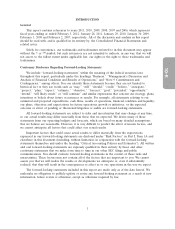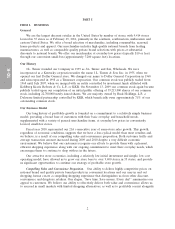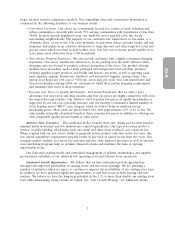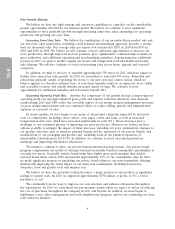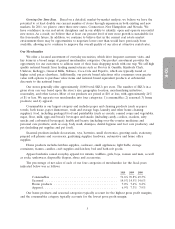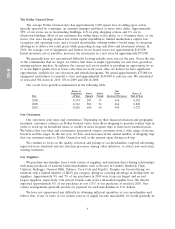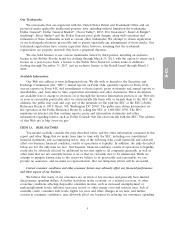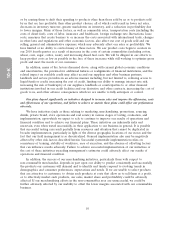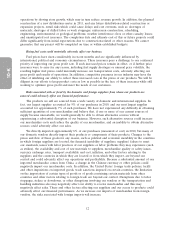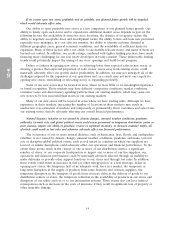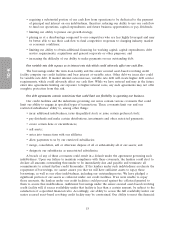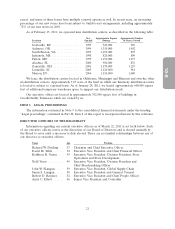Dollar General 2010 Annual Report Download - page 89
Download and view the complete annual report
Please find page 89 of the 2010 Dollar General annual report below. You can navigate through the pages in the report by either clicking on the pages listed below, or by using the keyword search tool below to find specific information within the annual report.
10-K
We face intense competition that could limit our growth opportunities and adversely impact our financial
performance.
The retail business is highly competitive. We operate in the basic discount consumer goods market,
which is competitive with respect to price, store location, merchandise quality, assortment and
presentation, in-stock consistency, and customer service. This competitive environment subjects us to
the risk of adverse impact to our financial performance because of the lower prices, and thus the lower
margins, required to maintain our competitive position. Also, companies like ours operating in the basic
discount consumer goods market (due to customer demographics and other factors) may have limited
ability to increase prices in response to increased costs without losing competitive position. This
limitation may adversely affect our margins and financial performance. We compete for customers,
employees, store sites, products and services and in other important aspects of our business with many
other local, regional and national retailers. We compete with retailers operating discount, mass
merchandise, outlet, warehouse club, grocery, drug, convenience, variety and other specialty stores.
Certain of our competitors have greater financial, distribution, marketing and other resources than we
do and may be able to secure better arrangements with suppliers than we can. These other competitors
compete in a variety of other ways, including aggressive promotional activities, merchandise selection
and availability, services offered to customers, location, store hours, in-store amenities and price. If we
fail to respond effectively to competitive pressures and changes in the retail markets, it could adversely
affect our financial performance.
Competition for customers has intensified in recent years as larger competitors have moved into,
or increased their presence in, our geographic markets. In addition, some of our large box competitors
are or may be developing small box formats which may produce more competition. We remain
vulnerable to the marketing power and high level of consumer recognition of these larger competitors
and to the risk that these competitors or others could venture into our industry in a significant way.
Generally, we expect an increase in competition.
Our private brands may not achieve or maintain broad market acceptance and increase the risks we face.
We have substantially increased the number of our private brand items, and the program is a
sizable part of our future growth plans. We believe that our success in gaining and maintaining broad
market acceptance of our private brands depends on many factors, including pricing, our costs, quality
and customer perception. We may not achieve or maintain our expected sales for our private brands.
As a result, our business, financial condition and results of operations could be materially and adversely
affected.
A significant disruption to our distribution network or to the timely receipt of inventory could adversely
impact sales or increase our transportation costs, which would decrease our profits.
We rely on our distribution and transportation network to provide goods to our stores in a timely
and cost-effective manner through deliveries to our distribution centers from vendors and then from
the distribution centers or direct ship vendors to our stores by various means of transportation,
including shipments by sea and truck. Any disruption, unanticipated expense or operational failure
related to this process could affect store operations negatively. For example, unexpected delivery delays
or increases in transportation costs (including through increased fuel costs or a decrease in
transportation capacity for overseas shipments) could significantly decrease our ability to make sales
and earn profits. In addition, labor shortages or work stoppages in the transportation industry or
long-term disruptions to the national and international transportation infrastructure that lead to delays
or interruptions of deliveries could negatively affect our business.
We maintain a network of distribution facilities and have plans to build new facilities to support
our growth objectives. Delays in opening distribution centers could adversely affect our future
11


